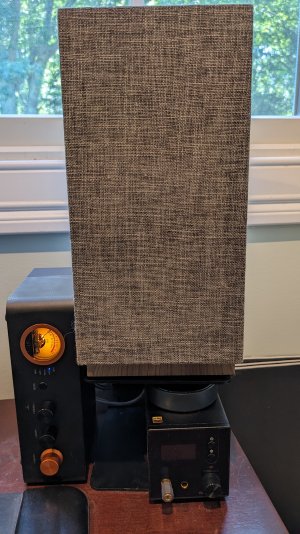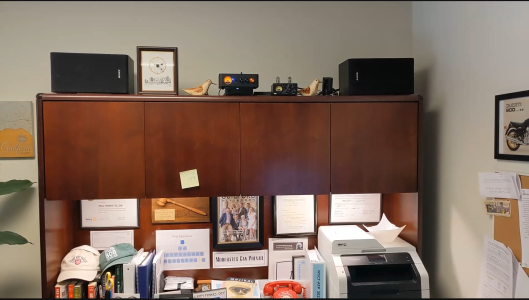The first impression is that the amplifier is larger and more solidly built than most other Class D amplifiers available now. It arrived well-packaged, up to Fosi Audio’s usual standards, and included a 32V/5A power supply, an optical cable, and a USB B to C cable. According to the included user manual, the twin amp chips the venerable TI 3255 and RMS power is 165 W X 2 @ 4ohms for the speaker pair. The passive subwoofer circuit has its a power rating of 350W, presumably from its own amp chip. The volume control does work for both subwoofer circuits. The sampling rate from USB is 24/bit/96kHz and via Optical/COA is 32bit/192kHz. The unit is powered on by turning the volume knob. There is no remote control function.
All my listening tests were conducted at the same decibel levels, measured by a phone app sound meter.
My first application was in my office, using a WiiM Mini streaming Spotify, either directly to the MC351 via optical or with a Topping E50 DAC Optical in, RCA out to the MC351. Speakers used were Sony SS-CS5 with a powered Yamaha YST-FSW150 subwoofer, with the latter connected via the pre-out. I’ve been using this setup for some time, with the only difference being a similarly power-rated Class D Douk Audio ST01 integrated amplifier.
In a like-for-like comparison, I was surprised at the improvement in sound. The MC351 offered better separation, a deeper, wider sound field, and more ‘air’. It’s a more detailed, yet pleasant sound, with the improved definition of drum hits, symbols, and any other short, sharp sounds at the top of the list.
I tested the MC351 with and without the Topping E50 DAC. The Topping takes credit for providing more authority, depth, and clarity, plus providing a pre-amp function with a remote control. While the MC351 is not necessarily too large to use as a desktop amp an arm’s length away, I can see this benefitting greatly from a remote control – either in Fosi Audio’s next version.
The one issue is a very significant, squint-inducing thump from the pre-out circuit through the subwoofer when turning the unit on – and again when turning it off. This boom doesn’t occur when not using the pre-out.
My second test was nearfield on my desk at home, using a WiiM Mini streamer either directly to the MC351 via optical or with an SMSL M300SE DAC/headphone amp to a pair of JAMO 801 speakers with no subwoofer. The previous amplifier was a Fosi Audio V3. In this case, the DAC on the MC351 offered about the same performance as the SMSL, most likely due to the mediocre quality of the speakers. The sound quality was comparable to the result achieved when using the V3 amplifier. This is a good indicator that it’s time to get better speakers.
To test the passive subwoofer connections, I used a vintage Altec Lansing Challenger 1 cabinet speaker, rated at 4ohms / 90dB@1W. This was interesting for three reasons: 1) the amp’s tone controls only affect the two main speakers, 2) you cannot change the sub’s volume relative to the two main speakers, and 3) you can’t set the step filter. Therefore, finding and matching a passive sub that compliments the two main speakers is important. In my case, the efficient sub was too forward.
My last test was in my workshop, where the MC351 replaced another Fosi Audio V3, this time using an Echo Link streamer tested with and without an SMSL SU1 DAC feeding Mission 700 speakers and a 250W-powered Polk PSW650 subwoofer. As in the first test, the MC351 showed off its downstream audio section by improving the definition, clarity, soundstage, and air to the better quality speakers.
Conclusion: The MC351 offers interesting performance in an attractive package. Although the venerable TI 3255 amp chip is common in comparable Class D amplifiers, it’s apparent that the downstream audio circuitry shows improvement. Although the claimed power output is dubious, it was easy to reach 85dB and more without issues. The VU meter moves much more than others I have at the same sound levels and spends much of its time in the upper registers. To be honest, this one serves no useful purpose, both because of its lack of accuracy and being alone in a stereo amp.
Using the pre-out to a powered sub resulted in significant ‘thumps’ when turning the unit on and off, which is concerning. For those few with passive subwoofers, there’s no level control or highpass filter to dial them in. I prefer using these amps with external DACs with remote controls as ‘pre-amps’, but the DAC in the MC351 performed well enough on its own.
I would say the MC351 offers better sound than expected and is designed to accommodate other quality components. As a good starting point it has the inputs of an integrated amplifier, an acceptable DAC, and now needs to offer better subwoofer management and a remote control.
All my listening tests were conducted at the same decibel levels, measured by a phone app sound meter.
My first application was in my office, using a WiiM Mini streaming Spotify, either directly to the MC351 via optical or with a Topping E50 DAC Optical in, RCA out to the MC351. Speakers used were Sony SS-CS5 with a powered Yamaha YST-FSW150 subwoofer, with the latter connected via the pre-out. I’ve been using this setup for some time, with the only difference being a similarly power-rated Class D Douk Audio ST01 integrated amplifier.
In a like-for-like comparison, I was surprised at the improvement in sound. The MC351 offered better separation, a deeper, wider sound field, and more ‘air’. It’s a more detailed, yet pleasant sound, with the improved definition of drum hits, symbols, and any other short, sharp sounds at the top of the list.
I tested the MC351 with and without the Topping E50 DAC. The Topping takes credit for providing more authority, depth, and clarity, plus providing a pre-amp function with a remote control. While the MC351 is not necessarily too large to use as a desktop amp an arm’s length away, I can see this benefitting greatly from a remote control – either in Fosi Audio’s next version.
The one issue is a very significant, squint-inducing thump from the pre-out circuit through the subwoofer when turning the unit on – and again when turning it off. This boom doesn’t occur when not using the pre-out.
My second test was nearfield on my desk at home, using a WiiM Mini streamer either directly to the MC351 via optical or with an SMSL M300SE DAC/headphone amp to a pair of JAMO 801 speakers with no subwoofer. The previous amplifier was a Fosi Audio V3. In this case, the DAC on the MC351 offered about the same performance as the SMSL, most likely due to the mediocre quality of the speakers. The sound quality was comparable to the result achieved when using the V3 amplifier. This is a good indicator that it’s time to get better speakers.
To test the passive subwoofer connections, I used a vintage Altec Lansing Challenger 1 cabinet speaker, rated at 4ohms / 90dB@1W. This was interesting for three reasons: 1) the amp’s tone controls only affect the two main speakers, 2) you cannot change the sub’s volume relative to the two main speakers, and 3) you can’t set the step filter. Therefore, finding and matching a passive sub that compliments the two main speakers is important. In my case, the efficient sub was too forward.
My last test was in my workshop, where the MC351 replaced another Fosi Audio V3, this time using an Echo Link streamer tested with and without an SMSL SU1 DAC feeding Mission 700 speakers and a 250W-powered Polk PSW650 subwoofer. As in the first test, the MC351 showed off its downstream audio section by improving the definition, clarity, soundstage, and air to the better quality speakers.
Conclusion: The MC351 offers interesting performance in an attractive package. Although the venerable TI 3255 amp chip is common in comparable Class D amplifiers, it’s apparent that the downstream audio circuitry shows improvement. Although the claimed power output is dubious, it was easy to reach 85dB and more without issues. The VU meter moves much more than others I have at the same sound levels and spends much of its time in the upper registers. To be honest, this one serves no useful purpose, both because of its lack of accuracy and being alone in a stereo amp.
Using the pre-out to a powered sub resulted in significant ‘thumps’ when turning the unit on and off, which is concerning. For those few with passive subwoofers, there’s no level control or highpass filter to dial them in. I prefer using these amps with external DACs with remote controls as ‘pre-amps’, but the DAC in the MC351 performed well enough on its own.
I would say the MC351 offers better sound than expected and is designed to accommodate other quality components. As a good starting point it has the inputs of an integrated amplifier, an acceptable DAC, and now needs to offer better subwoofer management and a remote control.
Attachments
Last edited:




